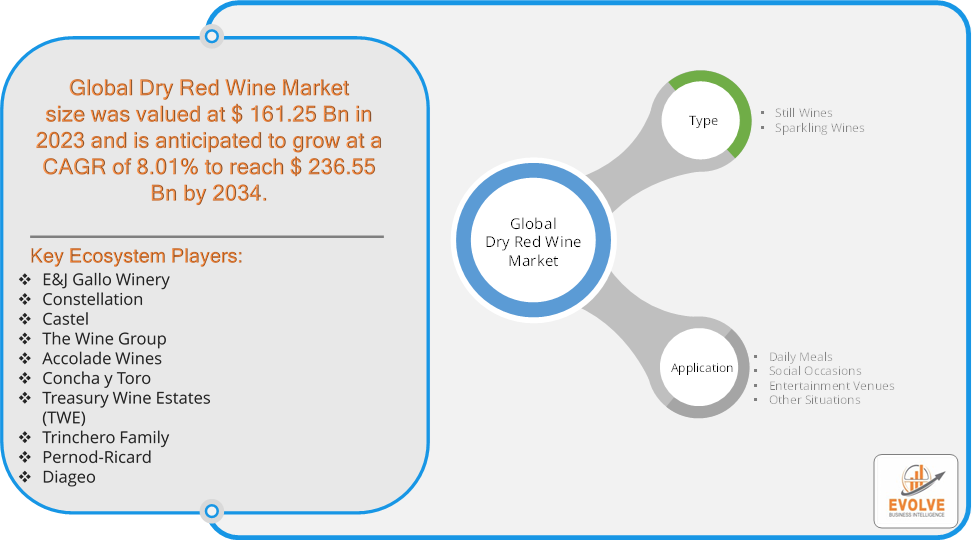Blog
Dry Red Wine Market Grows: 8.01% CAGR

Evolve Business Intelligence has published a research report on the Global Dry Red Wine Market, 2024–2034. The Global Dry Red Wine Market is projected to exhibit a CAGR of around 8.01% during the forecast period of 2024 to 2034.
Evolve Business Intelligence has recognized the following companies as the key players in the Global Dry Red Wine Market: E&J Gallo Winery, Constellation, Castel, The Wine Group, Accolade Wines, Concha y Toro, Treasury Wine Estates (TWE), Trinchero Family, Pernod-Ricard and Diageo.
The Global Dry Red Wine Market is projected to be valued at USD 236.55 Billion by 2034, recording a CAGR of around 8.01% during the forecast period. The Global Dry Red Wine Market refers to the worldwide market for dry red wines, which are red wines that contain very little residual sugar and are not sweet. Dry red wines are produced by fermenting red or black grapes, and the fermentation process is allowed to complete fully, so that most of the sugar is converted into alcohol.
This market is part of the broader alcoholic beverages industry, and consumer preferences, along with innovations in production and distribution, will shape its future trends. The global dry red wine market is a complex and dynamic industry that is influenced by a variety of factors.
Download the full report now to discover market trends, opportunities, and strategies for success.
Segmental Analysis
The Global Dry Red Wine Market has been segmented based on Type and Application.
Based on Type, the Global Dry Red Wine Market is segmented into Still Wines and Sparkling Wines. The Still Wines segment is anticipated to dominate the market.
Based on Application, the Global Dry Red Wine Market has been divided into Daily Meals, Social Occasions, Entertainment Venues and Other Situations. The Daily Meals segment is anticipated to dominate the market.
Regional Analysis
The Global Dry Red Wine Market is divided into five regions: North America, Europe, Asia-Pacific, South America, and the Middle East, & Africa. Wine consumption is increasing in North America, with consumers showing a strong preference for premium and high-quality red wines. The U.S. is a major consumer of dry red wine, particularly in states like California, Washington, and Oregon, which are also significant wine-producing regions and the rise of online wine sales and wine subscription services in the U.S. and Canada is contributing to the market’s growth. Europe is the largest producer and consumer of dry red wine, with countries like France, Italy, Spain, and Portugal leading in production and growing interest in organic and sustainable wines provides an opportunity for European producers to cater to eco-conscious consumers. The Asia-Pacific region, particularly China, Japan, South Korea, and India, is experiencing significant growth in red wine consumption. The expanding middle class and increasing disposable incomes are fueling demand for wine, especially premium and imported dry red wines and Wine is becoming increasingly popular as a status symbol and is being incorporated into social and business occasions in countries like China and Japan. In Latin America region, Countries like Chile, Argentina, and Brazil are becoming important players in the global dry red wine market. Chile and Argentina are known for their premium red wines, such as Malbec and Carmenere and Wine consumption is growing in the region, with an increasing appreciation for locally-produced red wines. Due to cultural and religious restrictions in many parts of the Middle East, the dry red wine market is relatively limited. However, certain countries like Israel and South Africa are notable players and South Africa is a key wine producer, particularly in the Western Cape region, and is known for producing high-quality red wines that are gaining international recognition.


